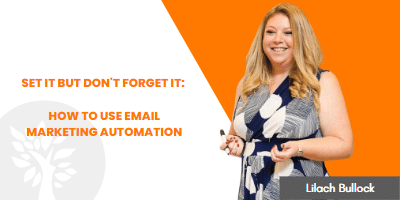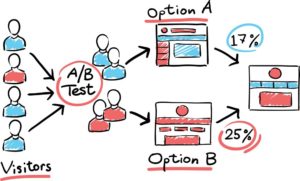Follow Lilach

Set It But Don’t Forget It: How to Use Email Marketing Automation
Email marketing isn’t new and it isn’t trendy but it’s got one thing in its favour – when it’s done right, it’s devastatingly effective. Other mediums have their place in your overall marketing strategy, but few are likely to deliver a ROI that can even come close to email. Trends come and go and social networks rise and fall but email continues to prove its worth for driving sales, raising brand awareness and delivering highly targeted marketing messages. But how to use email marketing automation?
Set It But Don’t Forget It: How to Use Email Marketing Automation
There’s a reason why email marketing automation works: it’s one of the best means of delivering hyper-targeted messages that appeal to the reader. If an email newsletter is driving down the street with a megaphone then email automation is knocking on the door of each house in that street and asking how you can be of service. Given the dozens or hundreds of email most of us receive each week, there simply isn’t time to go through them all. Those that can address a specific need we have and speak to us directly are far more likely to be given the time of day – and achieving that calls for more than correctly placing our name in the subject field.
The best email automation campaigns are carefully structured, comprising a sequence of messages that guide the reader towards a specific goal or action. Some may have a strong sales thrust, while others may be more informational and geared around building trust. Nevertheless, the desired outcome is the same: to convert a portion of the subscribers on your list into customers, and the more accurately you can target your marketing messages, the higher that conversion rate is going to be.
Set and forget?
 There’s an assumption, when it comes to marketing automation, that the hard work revolves around setting it up. You’ve got to craft multiple sequences of marketing messages, each one carefully worded and designed to lure the reader away from the territory marked Prospect and into the land marked Customer. You’ve got to write them, sequence them, load them into your mailer, double check the capture form on your landing page is working and then – and only then – sit back and let the automation take over. That’s how it works, right?
There’s an assumption, when it comes to marketing automation, that the hard work revolves around setting it up. You’ve got to craft multiple sequences of marketing messages, each one carefully worded and designed to lure the reader away from the territory marked Prospect and into the land marked Customer. You’ve got to write them, sequence them, load them into your mailer, double check the capture form on your landing page is working and then – and only then – sit back and let the automation take over. That’s how it works, right?
Not quite. It’s true, the first stage goes exactly as described – that’s how you set up email marketing automation. But if you think you can set it and forget it, well, forget it. That’s not how it works. Marketing automation is like owning a garden: there’s the hard work you put in creating that garden and then there’s the on-going maintenance you perform, removing weeds and nurturing growth. And, just like a beautiful garden, the more work you put in, the greater the rewards you’ll reap.
How to optimise your marketing automation
There are two primary ways to go about maintaining that garden you’ve lovingly created:
- Cleanse and segment your data
- Optimise and perform A/B testing
 The first of these should be axiomatic. You want to keep your marketing lists up to date because that lowers the rejection rate and saves money on your monthly plan. There’s no point in retaining a 100k mailing list for the bragging rights, knowing that half of those addresses are dead or inactive. Periodically prune your list and not only will you save money, but you’ll see your open rate go up. With more ‘active’ data to focus on, you’ll now be able to get a better feel for your audience, and will gain a deeper insight into their needs.Once you’ve gotten into the habit of periodically cleansing your lists, and have begun paying close attention to the clues that are scattered throughout your analytics, you’ll be in a position to segment your lists. If a subset of your audience is particularly responsive to messages based around a specific topic, filter these into a separate list and then give them more of what they crave. Don’t go overboard though: if you’ve ever bought a product from Amazon and then been bombarded with emails begging you to buy countless variations of the same product, you’ll understand. There’s only so many cheese graters you can buy and there’s only so many times you can market a specific product at your email list.
The first of these should be axiomatic. You want to keep your marketing lists up to date because that lowers the rejection rate and saves money on your monthly plan. There’s no point in retaining a 100k mailing list for the bragging rights, knowing that half of those addresses are dead or inactive. Periodically prune your list and not only will you save money, but you’ll see your open rate go up. With more ‘active’ data to focus on, you’ll now be able to get a better feel for your audience, and will gain a deeper insight into their needs.Once you’ve gotten into the habit of periodically cleansing your lists, and have begun paying close attention to the clues that are scattered throughout your analytics, you’ll be in a position to segment your lists. If a subset of your audience is particularly responsive to messages based around a specific topic, filter these into a separate list and then give them more of what they crave. Don’t go overboard though: if you’ve ever bought a product from Amazon and then been bombarded with emails begging you to buy countless variations of the same product, you’ll understand. There’s only so many cheese graters you can buy and there’s only so many times you can market a specific product at your email list.
Optimising your marketing emails
If we jump back to the garden analogy for a moment, when you plan that green and leafy space, you’ll have an idea of the plants you want and where you wish to place them. Fast forward six months and your marigolds are suffering because they’re not getting enough sunlight. That’s when you step in and rejig – or optimise – your garden. There are all kinds of variables you can optimise and alter with your email marketing, and you might be surprised at just how much difference the tiniest of changes can make. That’s why you A/B test.
Subject lines is an obvious example, and one of the easiest to tinker with: many email providers will let you live test two different subject lines on a small section of your list. The remainder of the mailshot will then be sent out to the version that’s recorded the best open rate. You can manually do this yourself though: devise a handful of strong subject lines for each automated email and test each one in turn. That’s the beauty of having a database: in addition to being your audience, they’re also your guinea pigs, a live test group whose every action or inaction feeds into your analytics and helps you optimise your emails.
 Speaking of optimisation, there’s a lot more that can be A/B tested than merely subject lines. You can trial different wording on your CTAs, different images and different positioning of sales elements within your emails. Improve your click-through rate by just 1% with a 100k mailing list and that’s an extra 1,000 high intent visitors landing on your site. While you’re optimising your emails, pay attention to timing. If you’re in the health and fitness industry, you might find that Mondays, when everyone’s paying penance for a weekend of overindulgence, delivers the best response rate. If you’re in B2B, Monday’s probably a bad day for driving sales, but don’t assume this – prove this with A/B testing, until you settle on that sweet spot that yields maximum results.
Speaking of optimisation, there’s a lot more that can be A/B tested than merely subject lines. You can trial different wording on your CTAs, different images and different positioning of sales elements within your emails. Improve your click-through rate by just 1% with a 100k mailing list and that’s an extra 1,000 high intent visitors landing on your site. While you’re optimising your emails, pay attention to timing. If you’re in the health and fitness industry, you might find that Mondays, when everyone’s paying penance for a weekend of overindulgence, delivers the best response rate. If you’re in B2B, Monday’s probably a bad day for driving sales, but don’t assume this – prove this with A/B testing, until you settle on that sweet spot that yields maximum results.
Email marketing automation is a holistic process, one which calls for more than simply writing a bunch of emails and then feeding them into your mailer. Rather, it’s an ongoing process, one which should be monitored regularly and refined periodically. There’s no such thing as the perfect email sequence, but that doesn’t mean you should settle for ‘good enough’. Every time you optimise your emails, your opens, click-throughs and conversions will creep higher and so will your ROI. Set it, but whatever you do, don’t ever forget it.

Follow Lilach
















